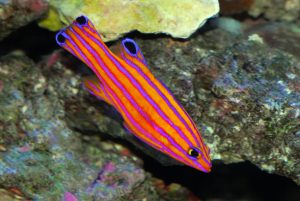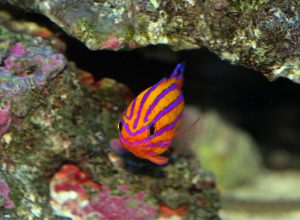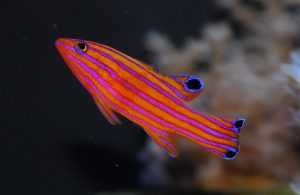It’s been a while since I last wrote an article about fish and that’s primarily because I couldn’t think of anything interesting to write about (at least nothing that interested me). Well, I recently obtained “my” Holy Grail of marine aquarium fish, the Candy Basslet (Liopropoma carmabi), and that gave me the impetus to write again.
The Candy Basslet is part of the larger family (Serranidae) of sea basses, groupers and reef basslets. It’s one of 23 to 27 species (depending upon whom you cite) of reef basslets in the subfamily Liopropomini. The reef basslets have always been some of my favorite aquarium fish because they’re generally hardy, attractive, easy to feed, disease-resistant, and remain small. Also, since they do not pick at sessile invertebrates, they’re an ideal choice for the coral reef aquarium. One caveat: They will eat any shrimp or crab that’s small enough to fit into their mouth. This is less of an issue with the smaller members of genus, such as the Candy Basslet, but something to consider with larger species, such as the Wrasse Bass (L. eukrines), which can reach 6 inches in length.
All the reef basslets are somewhat cryptic by nature and inhabit the caves and crevices of rocky reef structures. Depending upon the size of the aquarium, other inhabitants, lighting and décor, they will become bolder over time. All Liopropoma species share the same torpedo-shaped body and many have horizontal stripes. The Candy Basslet is most similar in size and coloration to the Swissguard Basslet (L. rubre) and Swales Basslet (L. swalisi) but is easily differentiated by its more intense coloration. Although specimens can vary in color and intensity, the Candy Basslet generally sports bright lavender and red lines against an orange body. The colors can be so intense as to make it difficult to photograph (the colors tend to “bloom” in photographs). It’s arguably the most beautiful and brightly colored of all the coral reef fish. The coloration tends to make up for what it lacks in size. As indicated earlier, the Candy Basslet is a relatively small fish growing to a maximum adult size of about 2 1/2 inches.

The Candy Basslet (Liopropoma carmabi) does best in a reef aquarium decorated heavily with live rock. It’s dashing into a crevice in the rockwork in this picture.
The Candy Basslet generally accepts all meaty seafood in the aquarium, such as Mysis shrimp, enriched brine shrimp, shredded krill, squid and clam. Over time it may accept flake and pellet foods, but I prefer to feed fresh frozen foods exclusively.
The Candy Basslet is one of five species of Liopropoma that occur in the tropical Atlantic Ocean. It ranges from the Bahamas and Florida Keys, along the eastern Caribbean, and down to some of the smaller islands (Curacao, Bonaire, and Ascension) off the northern coast of South America. In its natural range, it inhabits caves and rocky recesses between 50 and 250 feet, with most specimens found below 80 feet. Given its reclusive lifestyle and deep-water habitat, they are not commonly collected for the aquarium trade. When they do appear, they command a very high price.
Candy Basslets are generally observed as solitary individuals, and since they are not sexually dimorphic or sexually dichromatic (you can’t visually tell the difference between males and females), it’s best to maintain them alone. If you have a large reef aquarium (135 gallons or greater), and a big budget to match, you can add more than one specimen. Each one will stake out a territory in the rock structure. To my knowledge, none of the reef basslets have been bred in captivity to date; although they have exhibited spawning behavior.

The author’s Candy Basslet (Liopropoma carmabi) peers from its cave located in a 12 gallon nano-reef aquarium.
Given its size and reclusive nature, I think its best to maintain the Candy Basslet in a smaller reef aquarium (30 gallons or less). I’ve kept two related basslets (L. mowbrayi & L. rubre) in my 500 gallon reef aquarium for many years but I rarely see them. It would be a shame to throw this fish into a large mixed reef aquarium and never get to enjoy its beauty and unique habits. Regardless of the size of the aquarium, the Candy Basslet is best maintained in a reef aquarium decorated heavily with live rock and, ideally, under subdued illumination. The Swissguard Basslet (L. rubre) and Ridgeback Basslet (L. mowbrayi) in my large reef aquarium only venture out of the rocks for any length of time after the main lights turn off.
I presently keep my Candy Basslet in a 12 gallon nano-reef aquarium alongside my desk at my home office. This tank is lit with two 24 watt compact fluorescent lamps. The Candy Basslet is always visible and active as it moves between rocks in the aquarium. It often parks itself under a rock ledge at the front of the aquarium and gives the appearance of “begging” for food. The only tankmates are a neon goby (Gobiosoma oceanops) and small blennie (Ecsenius sp.). The Candy Basslet is a passive fish and compatible with most other fish, with the possible exception of conspecifics (other Candy Basslets); although it will mix well other small reef basslets, such as the Ridgeback Basslet. I wouldn’t house the Candy Basslet with any Pseudochromids or wrasses, especially in a smaller reef aquarium. It would be fine with Grammas, Anthias, Tangs and most Angelfish.

The Candy Basslet (Liopropoma carmabi) shares it’s aquarium with a few other passive fish, including this combtooth blennie (Ecsenius sp.).
If you can find a Candy Basslet, be sure to look it over closely for signs of swim bladder damage before plunking down your cash. The swim bladder can be injured if the fish is not properly decompressed after collection. It should be able to hold a perfect horizontal position in the water without any indication of a struggle. Although Candy Basslets are not prone to disease, I’d still recommend a period of quarantine in hyposalinity. I would not treat it with any medication prophylactically.
The coloration of Candy Basslets can vary between specimens from beautiful to spectacular, so keep an eye out for this as well. You also want to be careful not to confuse a Candy Basslet with similar and more common basslets, such as the Swissguard or Swales Basslet. The distinguishing characteristic, outside of the more intense coloration of the Candy Basslet, is that the Candy Basslet lacks a black spot on its anal fin, which is clearly visible in adult Swissguard and Swale’s Basslets.
Candy Basslets should start eating after a day of settling down in the aquarium. If not, you can entice them with some enriched live adult brine shrimp. You should be able to wean them off live food relatively quickly.

Larger reef basslets, such as this Wrasse Bass (Liopropoma eukrines) are more of a threat to small shrimp and crabs in the aquarium.
Before parting, I need to acknowledge Chris Pirhalla and Chris Meckley of FINZ in Tampa, Florida, without whom I would not have obtained my Holy Grail. Although it’s a relatively new store, FINZ already have a reputation for the rare and unusual and cater to the high-end reef aquarist. They’re located at 150 South Dale Mabry Highway in Tampa (813-873-0555).




0 Comments